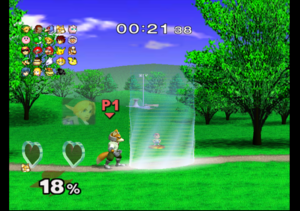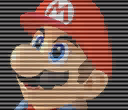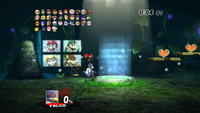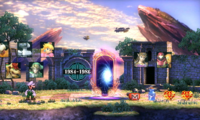All-Star Mode: Difference between revisions
m (Reverted edits by 174.24.183.175 (talk) to last version by Black Vulpine.) |
|||
| Line 383: | Line 383: | ||
*Clearing All-Star mode with all characters (including alternate characters that can be switched in) gives the player the [[Plusle & Minun]] trophy. | *Clearing All-Star mode with all characters (including alternate characters that can be switched in) gives the player the [[Plusle & Minun]] trophy. | ||
*Clearing All-Star mode without using continues gives the player the [[Pichu]] trophy. | *Clearing All-Star mode without using continues gives the player the [[Pichu]] trophy. | ||
*Clearing All-Star mode on any difficulty with any character will give the player a | *Clearing All-Star mode on any difficulty with any character will give the player a "Final Smash" trophy of the character used. | ||
===In ''Super Smash Bros. for Nintendo 3DS''=== | ===In ''Super Smash Bros. for Nintendo 3DS''=== | ||
Revision as of 23:31, December 9, 2017
All-Star Mode (オールスター) is a gameplay mode available in Super Smash Bros. Melee, Super Smash Bros. Brawl, and Super Smash Bros. 4 that pits the player against every non-Mii playable character in the game. The character chosen has only one stock in this mode, and is given a limited number of recovery items in order to recover damage. In Melee and Brawl, it is unlocked by unlocking every character within the game, but it is available from the start in Smash 4.
Super Smash Bros. Melee
All-Star mode made its debut in Super Smash Bros. Melee, as an unlockable 1-player mode which puts the player up against every playable character in the game.
During each battle, the player fights up to three different characters selected at random, overall fighting every character once. However, Mr. Game and Watch is always fought last, in a team of 25. Each opponent (except Mr. Game & Watch) wears one of their first three alternate costumes (not their default costume). If the player's character is wearing one of the first three alternate costumes and fights the same character, that opponent can wear its default costume but not the same costume as the player. Mr. Game & Watch will always wear his default costume, unless the player uses Mr. Game & Watch in his default costume, in which case they will wear the red costume.
For the first four battles, the player battles against one opponent. After four battles, the player will battle against two opponents per battle. After eight battles, the player will battle against three opponents per battle until the last fight against Team Mr. Game & Watch.
The characters are fought on the home stage of the first opponent in the group; for example, if the opponents were Luigi, Pikachu, and Ice Climbers, the stage would be Mushroom Kingdom. Past stages are excluded (like in Classic Mode), so neither that nor Big Blue are ever fought in on All-Star Mode.
Unlike Classic Mode and Adventure Mode, the player's percentage does not revert to 0% between battles. Players can only recover health by using one of three Heart Containers available between matches located in the All-Star Rest Area. These Heart Containers, unlike normal containers, heal the player up to 999% (restoring the player to 0%, as they did in the Super Smash Bros.) instead of only healing 100% damage. However, if the player enters the portal while damage is being healed, then the damage does not heal any further, and the next match will start with the same amount of damage the player had when he or she entered the portal. Once they are consumed, they are gone for the rest of the mode.
While players can use Ness's PSI Magnet and Mr. Game & Watch's Judgement to recover health, there is no other way to recover with the exception of the Heart Containers (which only appear in the All-Star Rest Area); items such as food, Maxim Tomatoes, and eggs do not appear at all in the mode.
As a reward, the player can also collect random trophies that appear after every three battles.
For some characters, particularly characters with a home stage set outside their universe, the stage will have a specially selected track from their series play; this is the only time these tracks can play on these stages. For example, Pichu's stage is set as Fourside, but the "Battle Theme" plays. The only exception is Ganondorf, for whom the normal Brinstar Depths music is played.
| First character | Stage | Music |
|---|---|---|
| Dr. Mario | Mushroom Kingdom II | "Dr. Mario" |
| Mario | Rainbow Cruise | "Rainbow Cruise" |
| Luigi | Mushroom Kingdom | "Mushroom Kingdom" |
| Bowser | Yoshi's Island | "Super Mario Bros. 3" |
| Peach | Princess Peach's Castle | "Princess Peach's Castle" |
| Yoshi | Yoshi's Story | "Yoshi's Story" |
| Donkey Kong | Kongo Jungle | "Kongo Jungle" |
| Captain Falcon | Mute City | "Mute City" |
| Ganondorf | Brinstar Depths | "Brinstar Depths" |
| Falco | Venom | "Venom" |
| Fox | Corneria | "Corneria" |
| Ness | Onett | "Mother" |
| Ice Climbers | Icicle Mountain | "Icicle Mountain" |
| Kirby | Green Greens | "Green Greens" |
| Samus | Brinstar | "Brinstar" |
| Zelda | Temple | "Temple" |
| Link | Great Bay | "Great Bay" |
| Young Link | Jungle Japes | "Saria's Song" |
| Pichu | Fourside | "Battle Theme" |
| Pikachu | Pokémon Stadium | "Pokémon Stadium" |
| Jigglypuff | Poké Floats | "Poké Floats" |
| Mewtwo | Battlefield | "Poké Floats" |
| Mr. Game & Watch | Flat Zone | "Flat Zone" |
| Marth | Fountain of Dreams | "Fire Emblem" |
| Roy | Final Destination | "Fire Emblem" |
Bold denotes a track that will not play on that stage in Versus Mode.
Super Smash Bros. Brawl
All-Star Mode returns in Brawl, and is mostly unchanged from Melee. The player still gets 3 Heart Containers (6 in co-op mode, the new 3 being underneath the platforms the normal 3 are on), random Trophies (but they will not appear as a question mark if the game is paused), and fight through every character in the game. The player still only has 1 stock, and they do not regain health between matches without a Heart Container (although the player can now enter the teleporter without having to wait for their health to fully recover).
In addition to Ness and Mr. Game & Watch, Lucas and Peach can heal themselves without a heart container by using PSI Magnet and Peach Blossom respectively.
However, instead of the matches having progressively larger enemy teams in random order (with an exception being a character being fought last every single time; as on All-Star Mode in Melee where Mr. Game & Watch was the last one); the order the opponents are fought is based on the first game in their series to be released (in Japan) with characters from the oldest series being fought first. As such, the player will always fight Mr. Game & Watch first and Olimar last, with Olimar's difficulty ramped up. In effect, this means that stages for Kid Icarus, Ice Climber, and Pikmin will be easier than Mario, The Legend of Zelda, and Pokémon, due to the latter three universes having multiple opponents.
Up to two enemies can appear on the stage at once; when a series has more than two representatives, a new fighter will appear a few seconds after the player KOs one of the opponents. On stages with multiple opponents, the order of the opponents is random.
To defeat Pokémon Trainer, the player must defeat Squirtle, Ivysaur and Charizard; once one is defeated, Pokémon Trainer will send out the next one. For Metroid, the player will battle either Samus or Zero Suit Samus, selected at random; for The Legend of Zelda, the player will battle either Zelda or Sheik, selected at random.
The stage the player fights each character on will be a home stage from Brawl, and the stage is randomly selected if there is more than one opponent; like in Classic mode, however, Past Stages cannot be selected. However, Super Smash Bros. universe stages like Battlefield and Final Destination are not considered home stages for any character in this version's All-Star Mode. Unlockable stages will not appear unless the player has unlocked them. Mario Bros. is R.O.B.'s home stage and does not appear as a Mario home stage; if Mario Bros. has not yet been unlocked, R.O.B. will appear in Delfino Plaza instead.
When the player finishes All-Star Mode with a character, they will enter Character Roll Call.
The order in which 'Universes' are fought is listed below:
Italics denote unlockable stages that the player is not guaranteed to have upon unlocking the mode.
- ^ No playable characters in Brawl are featured in the 1989 game Mother. The first game in the series which has characters featured as playable characters in Brawl is EarthBound/Mother 2, released in August 1994.
- ^ Wario's first appearance was actually the game Super Mario Land 2: 6 Golden Coins which was released in October 1992; however, according to Masahiro Sakurai on the Super Smash Bros. Brawl website, this is based on his first main role in Wario Land: Super Mario Land 3.[1]
As a reward for completing this mode, the player will earn a trophy of their character using their Final Smash. Additionally, the player will see an interesting congratulatory picture that plays according to what their fighter is. For example, for Snake, it shows Snake in his box with Zero Suit Samus and other various bounty hunters looking for him.
Co-op mode
All-Star mode in Brawl may be played with 2 players. When playing co-op, the player receives a total of 6 heart containers. Both players must remain alive at all times, and if either player is KO'd, both players are sent to the continue screen. The opponents are the same until the last battle where the players face 2 Olimars instead of one (a possible nod to Louie from Pikmin 2). Playing All-Star with 2 players allows them to receive two Final Smash trophies at the same time. However, co-op play does not count towards the Challenges for All-Star mode, such as clearing it with ten characters. The challenges only can be unlocked in solo; not co-op mode.
Super Smash Bros. 4
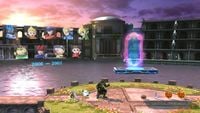
Unlike previous installments, All-Star mode is playable from the start of the game. However, the mode is incomplete at first, as players cannot fight against characters they have not yet unlocked. Once all unlockable characters have been unlocked, it is referred to as true All-Star mode, which is required for many of the rewards from the Challenges in Super Smash Bros. for Wii U. Downloadable characters will also be added to the mode if the player obtains them, but their presence or absence will not affect any of the challenges, and if the player deletes the DLC data, the downloadable characters will be removed from the mode, until they are re-downloaded.
The order in which different characters are fought is now based on a character's personal first appearance anywhere (all characters debuted first in Japan with the exception of Diddy Kong, Sonic and Zero Suit Samus, while Greninja debuted on the same day worldwide). In Super Smash Bros. for Nintendo 3DS, the order of opponents starts with the oldest characters (1980) and progresses to the newest ones (2015, or 2013 prior to Corrin); in Super Smash Bros. for Wii U, the order is reversed, with the newest characters fought first and the oldest ones fought last. Mii Fighters are not fought at all.
Up to three enemies can appear at a time (two if played on co-op in Super Smash Bros. for Nintendo 3DS) with four to nine opponents per stage with a five minute time limit. Stages are chosen randomly from some of the home stages of that era's characters (this includes stages that are not yet unlocked), but overly large stages such as Palutena's Temple, The Great Cave Offensive and 75m are never picked. Wii U stages will use their 8-Player Smash variant if applicable; similarly, some 3DS stages have certain elements removed, as noted below.
Ten characters with special alternate costumes can wear these costumes in All-Star Mode. Little Mac can wear his wireframe costume; Wario can wear his classic overall costume; Cloud can wear his Cloudy Wolf costume; Bayonetta can wear her original Bayonetta costume; Robin, Corrin and Wii Fit Trainer can be either male or female; and the Villager can wear any costume. Both Alph and the Koopalings can take the place of their original characters, Olimar and Bowser Jr., respectively; however, their appearances will seem misplaced in relation to the chronology, as Alph's debut in Pikmin 3 comes twelve years after Olimar's in Pikmin and the Koopalings' debut in Super Mario Bros. 3 predates Bowser Jr.'s debut in Super Mario Sunshine by fourteen years.
The recovery items available in the Rest Area are one Special Heart Container (healing 999%), a Maxim Tomato (healing 50%), a Fairy Bottle (healing 100%, but only if the player's damage is 100% or greater), and, if all characters are unlocked, a second Special Heart Container. In the Group version, two extra Special Heart Containers are added. If the player attempts to carry one of these items outside of the Rest Area (e.g. carrying the Fairy Bottle normally, or Pocketing an item), it will be lost without healing the player. Unlike in previous games, no items spawn at all during battles. In addition, while in the Rest Area, the player's damage is fixed and cannot be altered in any way outside the provided healing items—self-damaging moves (such as Judge) and self-healing moves (such as Sun Salutation) will not have any effect on the player's damage. Chomp cannot boost the effectiveness of healing items in the Rest Area.
While previous games used knockback handicaps to make each individual opponent easier to defeat, SSB4 instead uses damage multipliers to increase the damage dealt to opponents while reducing the damage taken by the player. Interestingly, the CPUs also have launch rates slightly below 1.0x, possibly to stop some moves from killing ridiculously early due to the damage multipliers. However, attacks from projectiles and other articles and props, such as Charizard's Flare Blitz, Olimar's Pikmin, and Ness's yo-yo, are not affected by the player's damage boost or the opponents' damage reduction. In addition, stage elements will deal full damage and knockback to players and enemies alike (such as falling onto the track in Mute City, which will reasonably KO the player at 110%). As a result, prop-based attacks and stage hazards are by far the greatest threats to the player in this mode, since the opponents will otherwise not be able to reliably KO the player otherwise until approximately 200%.
Unlike previous games, the player may not continue. If the player is defeated, any gold, trophies, and Custom Parts earned so far will be retained, but they must start over.
Additionally, the player is not allowed to use any customizations, as some equipment can sidestep the damage recovery limits that All-Star mode has. As a result, excluding the Miis, the player can only use the default special moves that each fighter has for this game mode.
When the player finishes All-Star Mode with a character, the credits will roll (Solo mode only), and they will earn the character's "(Alt.)" trophy (similar to Melee) in Super Smash Bros. for Nintendo 3DS or a Final Smash trophy (similar to Brawl) in Super Smash Bros. for Wii U; "(Alt.)" trophies in the Wii U version are instead randomly obtained from the Trophy Shop after beating Classic Mode or All-Star Mode with the character in question.
Italics denote unlockable characters. Bold italics denote characters that are only unlockable in Super Smash Bros. for Nintendo 3DS.
- ^ a b c d e f g h i j k l m n o p q r s Downloadable content. These characters and stages will not appear if they are not downloaded.
- ^ Dog and ducks do not appear.
- ^ Checkpoint lampposts do not appear.
- ^ Microgames do not occur.
- ^ Flying Men do not appear.
- ^ Fruits do not grow.
- ^ 2007-2013 prior to Corrin
Damage multipliers
| Stage | Player damage to enemies | Enemy damage to player |
|---|---|---|
| 2007-2015 | 2.6x | |
| 2001-2006 | 2.6x | |
| 1994-1998 | 2.655x | |
| 1991-1993 | 2.8x | |
| 1986-1990 | 2.4x | |
| 1984-1986 | 2.8x | |
| 1980-1983 | 2.8x |
Update history
- 8-Player Smash stage variants added in this update are now used in All-Star Mode.
- The Duck Hunt stage added as a free stage.
Rewards
In Super Smash Bros. Melee
- Clearing All-Star mode with any character will result in unlocking the Battlefield stage, as well the Battlefield trophy.
- Clearing All-Star mode on Hard or Very Hard gives the player the Mew trophy (continues can be used).
- Clearing All-Star mode without using continues gives the player the Wario trophy.
- Clearing All-Star mode with all characters gives the player the Meowth trophy.
- Clearing All-Star mode on any difficulty with any character will give the player a "Smash" trophy of the character used, each with an alternate costume (except Mr. Game & Watch who uses his default costume), independent of the "Smash" trophies earned in Adventure Mode. Both Zelda and Sheik's Smash Blue trophies are obtained simultaneously.
In Super Smash Bros. Brawl
- Clearing All-Star mode on Easy gives the player the Tal Tal Heights Music.
- Clearing All-Star mode on Normal gives the player a sticker of Phyllis.
- Clearing All-Star mode on Hard gives the player the Birdo trophy.
- Clearing All-Star mode on Very Hard gives the player the Dyna Blade trophy.
- Clearing All-Star mode on Intense gives the player the Mewtwo trophy.
- Clearing All-Star mode with 10 characters gives the player the Gekko trophy.
- Clearing All-Star mode with all characters gives the player the Kyle Hyde trophy.
- Clearing All-Star mode with all characters (including alternate characters that can be switched in) gives the player the Plusle & Minun trophy.
- Clearing All-Star mode without using continues gives the player the Pichu trophy.
- Clearing All-Star mode on any difficulty with any character will give the player a "Final Smash" trophy of the character used.
In Super Smash Bros. for Nintendo 3DS
- Clearing All-Star mode with any fighter will give the player an alternate trophy of the fighter in a different pose, and, with the exception of Pac-Man and Bowser Jr., in a different costume (similar to Melee) to the default trophy earned in Classic Mode.
- Clearing All-Star mode on Easy or harder will give the player a trophy of Epona.
- Clearing All-Star mode on Normal or harder will give the player a trophy of Medusa, Queen of the Underworld.
- Clearing All-Star mode on Hard will give the player a trophy of Nintendoji.
- Clearing All-Star mode with fifteen different characters will unlock the All-Star Rest Area music.
- Clearing All-Star mode with all characters will unlock a King hat for a Mii Fighter.
In Super Smash Bros. for Wii U
- Clearing All-Star mode with any fighter gives a trophy of the character's Final Smash like in Brawl.
- Clearing All-Star mode for the first time unlocks Victini as a Poké Ball Pokémon.
- Clearing All-Star mode on normal difficulty or higher gives the Hyper Smasher Brawn Badge equipment.
- This challenge is immune to the Golden Hammer.
- Clearing All-Star mode on normal difficulty gives the player the chance to battle Dark Pit. Beating him will unlock him.
- Clearing All-Star mode on hard difficulty with 8 or more characters gives the Caloric Immortal Protection Badge equipment.
- Clearing All-Star mode on hard difficulty with all characters gives the Saki Amamiya trophy.
- Clearing Solo All-Star mode on normal difficulty or higher while playing as Lucario unlocks Meloetta as a Poké Ball Pokémon.
- Clearing true All-Star mode on hard difficulty gives the Perfect-Shield Helper Brawn Badge equipment.
- This challenge is immune to the Golden Hammer.
- Clearing true Solo All-Star mode within 6 minutes as Jigglypuff gives the Koffing trophy.
- This challenge is immune to the Golden Hammer.
- Clearing true All-Star mode on normal difficulty or higher without the use of healing items gives 15,000G.
- This challenge is immune to the Golden Hammer.
- Clearing true Solo All-Star mode as Zero Suit Samus, without the use of healing items, gives the Gunship trophy.
- Clearing true Solo All-Star mode on hard as Ike gives the Black Knight trophy.
- Clearing true Solo All-Star mode on hard as Duck Hunt gives the Samus (Dark Suit) trophy.
- This challenge is immune to the Golden Hammer.
- Clearing true Solo All-Star mode within 6 minutes as Shulk gives the Mechonis trophy.
- Clearing true Solo All-Star mode on normal or higher as Captain Falcon, without the use of healing items, gives the Deathborn trophy.
Rest Area music
In Melee
All-Star mode is heavily based on Kirby Super Star's The Arena. In Melee, the music comes from The Great Cave Offensive's save cottages in Kirby Super Star. Interestingly enough, in Kirby Super Star Ultra, this music is used in The Arena between boss fights.
In Brawl
In Brawl, the music is a light, relaxed remix of Brawl's main theme.
In Smash 4
In Smash 4, the music is a light remix of the main theme.
Trivia
- The Pokémon Trainer is the only character in the entire series to use a revival platform in All-Star mode. This is because the player must KO all three of Pokémon Trainer's Pokémon.
- The Mii Fighters are the only characters in the entire series that are absent from All-Star mode.
- Super Smash Bros. for Wii U is the only game where the teleporter to the next battle is not on the main ground.
- Dark Pit is the only character that is unlocked by playing in this mode, and can be unlocked this way in Super Smash Bros. for Wii U.
See also
References
- ^ Masahiro Sakurai (2nd April, 2008). All-Star (text). Smash Bros. DOJO!!. Retrieved on 1st August 2014. “Wario's placement in All-Star mode”
| Super Smash Bros. Melee menu items | |
|---|---|
| Vs. Mode | Melee (Time · Stock · Coin Battle · Bonus · Team Battle) · Custom Rules · Special Melee · Tournament Mode · Names |
| 1-P Mode | Regular Match (Classic Mode · All-Star Mode · Adventure Mode) · Event Match · Stadium (Target Test · Home-Run Contest · Multi-Man Melee) · Training |
| Trophies | Gallery · Collection · Lottery |
| Options | Rumble · Sound · Screen Display · Language · Erase Data |
| Data | Snapshots · Melee Records · Sound Test · Archives (NTSC only) · How to Play (PAL only) |
| Unused | Debug menu · Debug sound test menu |
| Super Smash Bros. Brawl menu items | |
|---|---|
| Group | Brawl (Time · Stock · Coin Battle · Team Battle) · Rules · Special Brawl · Rotation · Tourney · Names |
| Solo | Classic · All-Star · Adventure Mode: The Subspace Emissary · Events · Stadium (Target Smash!! · Home-Run Contest · Multi-Man Brawl · Boss Battles) · Training |
| Wi-Fi | Spectator Mode · With Anyone · With Friends |
| Vault | Trophies & Stickers (Trophy Gallery · Trophy Hoard · Coin Launcher · Sticker Album · Sticker Center) · Stage Builder · Album · Challenges · Replays · Masterpieces · Chronicle |
| Options | Screen · Deflicker · Rumble · Controls · Sound · My Music · Erase Data |
| Data | Movies · Records (Group Records · Brawl Records · Notices) · Sound Test |
| Super Smash Bros. for Nintendo 3DS menu items | |
|---|---|
| Smash | Smash (Solo · Group · Time · Stock · Team Battle) · Rules |
| Smash Run | Solo · Group · Custom · Select Music |
| Games & More | Classic · All-Star · Stadium (Multi-Man Smash · Target Blast · Home-Run Contest) · Training · Custom · amiibo · Vault (Trophies · Trophy Rush · Album · Replays · Sounds · Records · Tips) · Options (Controls · Sound · Character Outline · Damage Display · Internet Options) |
| Online | Spectator Mode · With Anyone (For Fun · For Glory) · With Friends · Conquest · Share |
| Other | Challenge · StreetPass · Wii U |
| Super Smash Bros. for Wii U menu items | |
|---|---|
| Smash | Smash (Time · Stock · Coin Battle · Team Battle) · 8-Player Smash · Special Smash · Rules · Controls |
| Games & More | Classic · All-Star · Stadium (Target Blast · Home-Run Contest · Multi-Man Smash) · Training · Events · Special Orders (Master Orders · Crazy Orders) · Custom · Stage Builder · amiibo · Vault (Trophies · Trophy Rush · Album · Replays · Movies · Sounds · Records · Tips · Masterpieces) · Options (Controls · Sound · My Music · Internet Options) |
| Online | Spectator Mode · With Anyone (For Fun · For Glory) · With Friends · Online Events (Tourney · Conquest) · Share |
| Other | Challenge · Smash Tour · 3DS |
